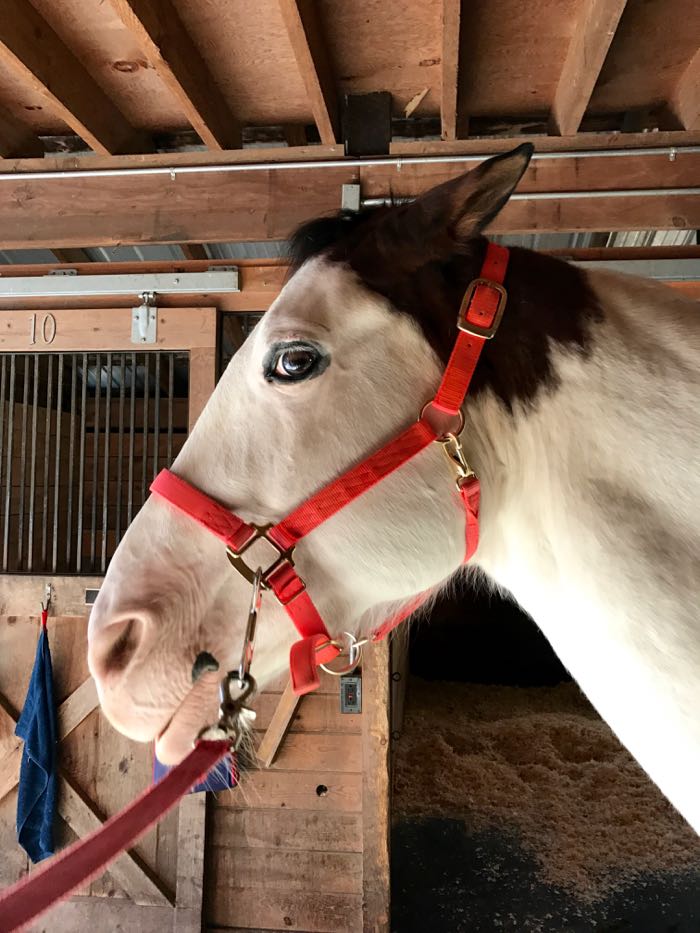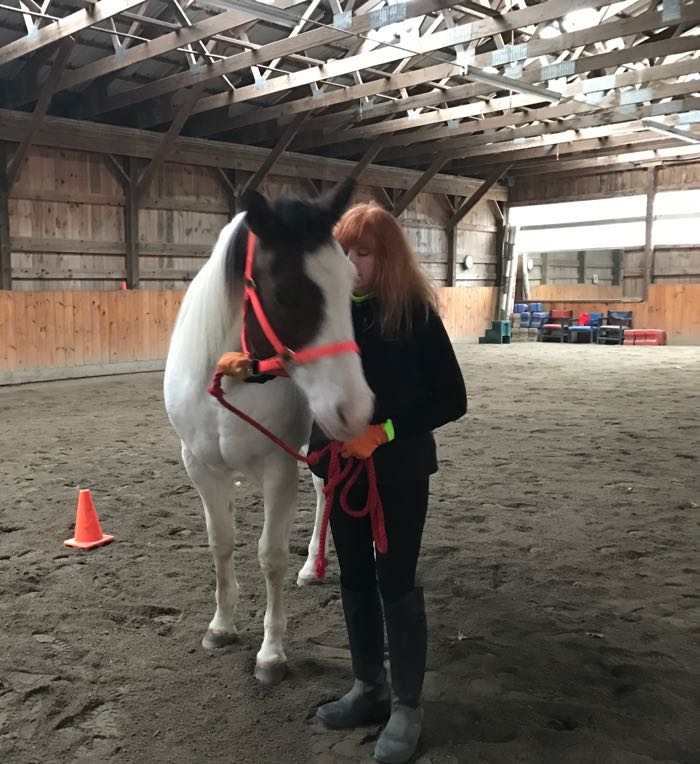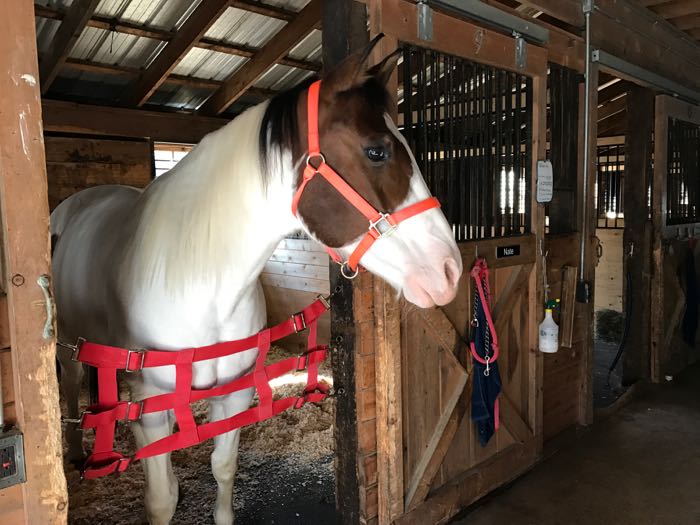Remember Nate?

When I first met him, he sent out signals loud and clear: DO NOT TOUCH. All horses will pin ears and wrinkle their lips when they want you to go away. But Nate had taken it a step further. He bit. He bit when feeling threatened. He bit when worried that he was in a situation that might be threatening. He bit when being led from here to there. He bit when he thought that a person had food on them. He bit to stop someone from touching him. It’s normal for horses to use body language to threaten. Watch horses in a paddock and you’ll see postures that range from ear flicks to bared teeth. However, it’s rare that horses connect, this body language is communication, and it’s usually short-lived and subtle. Nate, though, had come to believe that no-one was paying attention to his ears and that escalation was necessary.
Nate especially did not want to be touched on his face.
Look at him now.

This was accomplished with small steps, patience, and observation. I taught Nate’s owner, Eileen, how to read Nate’s body language. We reassured Nate that we’d listen to him. We touched him and let him tell us what he liked. We taught him self-control around food.
However, we’re still having biting issues in the indoor arena. Nate is extremely mouthy. When walking in the ring, he grabs Eileen’s arm when he wants her to walk slower or when he’s not sure what to do. Ignore him to talk to each other and he body blocks, reaches around and bites.

I had Eileen work on walking through cones.

Nate had his own idea.

Besides being hilarious (he happily weaved through the cones while carrying one in his mouth) this got me to thinking. Not all of Nate’s biting is triggered by aggression. Some of it is caused by insecurity. Having something in his mouth (even it is Eileen’s arm) is self-calming. Do you think that I could get a horse-sized pacifier? In all seriousness, I need to teach Nate not to bite.
With this odd behavior of carrying a cone (not normal for a horse!) one more piece of the puzzle fell into place. Although working in the indoor seemed like a sensible thing to do (it’s winter in New England and cold and icy outside,) Nate feels stressed there. In behavior science terms, the indoor had become a conditioned punisher. A good trainer works from a place of security. Where was that place for Nate? I asked him. When I first met Nate, I wouldn’t have understood his answer because he pinned his ears whenever I was near him. But we’d make progress. Now I would be able to hear his answer.
We went back to his stall. He was fine there. He also now stood happily in cross-ties. Nate was secure walking down the aisle and didn’t reach around to bite Eileen. We headed outside. He didn’t bite on the way to his paddock, but turn right toward the indoor and his eyes tensed. Nate’s overall demeanor is placid. You really have to look to see what he’s saying. We took a few more steps and his lips curled. Another step and his ears pinned. The message was clear. Nate did not want to go into the indoor ring. My job now is to change how he feels about that place. We will be working to expand Nate’s comfort zone. Before we step foot back in the ring, we’ll be working to make the path to it a relaxed place. Then the doorway, then the ring itself. The slower you go, the faster you’ll get there.
Nate is happy to be on this journey.



Watching with interest as I have the same thing with my horse. He is nipping headed to the outdoor ring and while in the ring.
I hope my posts give you an idea of how to handle this. Each case is different, but not escalating is a key. That said, stay safe! FYI, I do distance consultations (Skype, email, etc.) Check my Services Offered page.
Have followed from beginning, what a great result. Nate looks so different from the other side lovely profile. Shows what hard work, understanding and patience can accomplice, well done Nate, Eileen and Terry…:)
Eileen is committed, consistent and kind. This progress wouldn’t have happened without her. Thanks for giving her a shout-out 🙂
He changes from ugly to beautiful with the positive attitude change!
Don’t we all? 🙂
I love the change between photos!
Me too! It’s a visible affirmation that what we think is happening, really is.
First of all, Eileen is my hero. I am so impressed that she is doing all this work, and how lucky she is to find a trainer that understands how to unravel it. (And how beautiful is Nate in the picture of him being petted by Eileen?)
I have a suggestion. A few of my ex-races found indoor arenas to be terrifying places. In Nate’s case, it’s likely a place where bad and scarey things happened, even inadvertantly. For my ex-racers, who rarely had non-stressful contact with humans, as they were always being asked to do something hard, scary or fear-inducing. an open arena was just one more new environment…another potential stressor. Yet, like you, I had to use them in snowy times. Here’s what I did: I had a lovely, motherly, ridiculously calm permarin mare who was the equine babysitter of all time. She had been bred every heat since she was born (she was almost 16 when I bought her at auction, out of pure pity) and had had every foal taken from her way too early. She was always desperate to make equine connections. I would take half a bale of hay and spread it around in two or three clumps in the arena and turn her into the arena at liberty, with the nervous ex-racer. Sometimes they’d trot around together for a while, sometimes the racer would careen around in panic at first, the Premarin mare, Petunia, just staring at him. But eventually, if I left them in there, alone together, they would end up just calmly eating hay eventually side by side. The arena became an indoor ‘pasture’. I did it every day for weeks. Occasionally, I even left them ‘out’ together overnight. I owned the arena though, so it was easy to do. I realize Eileen’s situation is likely different. The only time I would approach the ex-racer while in the arena would be to offer peppermints, turn around and leave. Eventually, I’d offer a peppermint, quietly clip a lead on and walk him back to his stall. Repeat. Repeat. Desensitized him.
Also, do you think having a few of those rubber horse balls with ‘handles’ on them might be a comforting toy? You could put one or two in the arena amongst the hay.
Is there any other horse Nate can be ‘pastured’ with? A sensible horse who will stay calm? Leaving him and a buddy loose in the arena during a quiet time, with lots of hay might make a scary place a freeing place. Equine companionship is key here, I would think.
You came up with a very nice solution for your OTTB. Ah, yes, these things are easier when you have your own facility and a kind mare 🙂 Hay is not welcome in a carefully groomed indoor. Beyond that, because of his history, Nate is always the low guy in the hierarchy. He gets along with his paddock-mate, but that’s only because he knows how to get out of the way. No nice mares at this stable, in fact there’s only one and although we all love Maggie, oh, what a bossy horse! What we can do, once simply leading to the indoor becomes fine for him, is to lead him in one door, straight through and out the other.
We discussed giving him mouthing toys, but I’m concerned that he won’t differentiate between the toys and Eileen – he already tries to hold onto her. Instead, we’re teaching him to calm himself in other ways.
Festina lente (make haste slowly) is my barn motto =) I’ve known plenty of horses that really just liked to hold something in their mouth, some because of anxiety or stress, and some ‘just because’. There difference I saw between them was the anxious biter displayed the typical body language Nate displays. I’ve also known many many young colts who bit people because they didn’t have the opportunity to bite other horses (normal stud colt play behavior). One of the great mysteries of horses is that we don’t usually know their entire history, making it very hard to sort out root cause.
Festina lente sounds like a horse name 🙂 I think you’re right about play behavior being essential. I also believe that youngsters should be weaned later rather than earlier, and when they’re with their mothers, to also be in with Aunties. It’s always good to learn manners from your elders!
Do you have any blogs touching on biting in cinchy horses? Thanks for this one!
I don’t have a blog on that specifically, but I’ll work on one! In the meanwhile, first rule out pain – ulcers are often the cause. Or saddle/cinch pain. Then, observe the behavior carefully. When does it start? With the saddle pad? The saddle? The girth? If you handle the horse in the saddle area, is he comfortable if no saddle is around? There’s lots to be learned by close observation.